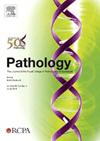TIGIT expression on neoplastic cells is a poor prognostic factor for adult T-cell leukaemia/lymphoma
IF 3.6
3区 医学
Q1 PATHOLOGY
引用次数: 0
Abstract
Adult T-cell leukaemia/lymphoma (ATLL) is an aggressive peripheral T-cell neoplasm with a poor prognosis. T-cell immunoreceptor with immunoglobulin and immunoreceptor tyrosine-based inhibitory motif domains (TIGIT) is an immune checkpoint receptor expressed on T and natural killer cells. Although increased TIGIT expression in the tumour microenvironment is associated with poor prognosis in various neoplasms, its relevance in ATLL remains unknown. Herein, we investigated the clinicopathological impact of TIGIT expression on ATLL using immunohistochemistry. TIGIT expression was detected in 21 of 84 patients (25%). A partial association between the clinical features and immune checkpoint molecules and the expression of TIGIT was found including sIL-2R, CD86 and GITR. TIGIT-positive patients [median survival time (MST) 8.9 months, 95% confidence interval (CI) 7.7–15.6] had inferior overall survival compared with TIGIT-negative patients (MST 18.7 months, 95% CI 12.0–36.4) (p=0.0124]. TIGIT expression maintained its prognostic value for overall survival in both univariate and multivariate analyses [hazard ratio (HR) 1.909; 95% CI 1.044–3.488; p=0.0356]. Further studies are required to clarify the clinical and biological significance of TIGIT expression in patients with ATLL.
肿瘤细胞上的 TIGIT 表达是成人 T 细胞白血病/淋巴瘤的不良预后因素
成人 T 细胞白血病/淋巴瘤(ATLL)是一种侵袭性外周 T 细胞肿瘤,预后较差。具有免疫球蛋白和免疫受体酪氨酸抑制结构域的T细胞免疫受体(TIGIT)是一种免疫检查点受体,在T细胞和自然杀伤细胞上表达。虽然肿瘤微环境中 TIGIT 表达的增加与多种肿瘤的不良预后有关,但其与 ATLL 的相关性仍不清楚。在此,我们采用免疫组化方法研究了 TIGIT 表达对 ATLL 的临床病理影响。84 例患者中有 21 例(25%)检测到 TIGIT 表达。临床特征和免疫检查点分子与 TIGIT 表达之间存在部分关联,包括 sIL-2R、CD86 和 GITR。与TIGIT阴性患者(中位生存时间(MST)18.7个月,95% 置信区间(CI)12.0-36.4)相比,TIGIT阳性患者(中位生存时间(MST)8.9个月,95% 置信区间(CI)7.7-15.6)的总生存率较低(=0.0124)。在单变量和多变量分析中,TIGIT表达对总生存期仍有预后价值[危险比(HR)1.909;95% CI 1.044-3.488;=0.0356]。要明确TIGIT表达在ATLL患者中的临床和生物学意义,还需要进一步的研究。
本文章由计算机程序翻译,如有差异,请以英文原文为准。
求助全文
约1分钟内获得全文
求助全文
来源期刊

Pathology
医学-病理学
CiteScore
6.50
自引率
2.20%
发文量
459
审稿时长
54 days
期刊介绍:
Published by Elsevier from 2016
Pathology is the official journal of the Royal College of Pathologists of Australasia (RCPA). It is committed to publishing peer-reviewed, original articles related to the science of pathology in its broadest sense, including anatomical pathology, chemical pathology and biochemistry, cytopathology, experimental pathology, forensic pathology and morbid anatomy, genetics, haematology, immunology and immunopathology, microbiology and molecular pathology.
 求助内容:
求助内容: 应助结果提醒方式:
应助结果提醒方式:


